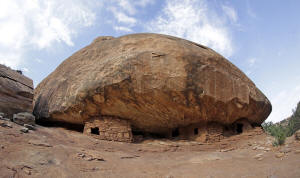Biden adds to the nation's list of national monuments during his term.
There's an appetite for more
 Send a link to a friend
Send a link to a friend
 [December 09, 2024]
By SUSAN MONTOYA BRYAN [December 09, 2024]
By SUSAN MONTOYA BRYAN
ALBUQUERQUE, N.M. (AP) — U.S. President Theodore Roosevelt did in 1906
what Congress was unwilling to do through legislation: He used his new
authority under the Antiquities Act to designate Devils Tower in Wyoming
as the first national monument.
Then came Antiquities Act protections for the Petrified Forest in
Arizona, Chaco Canyon and the Gila Cliff Dwellings in New Mexico, the
Grand Canyon, Death Valley in California, and what are now Zion and
Bryce Canyon national parks in Utah.
The list goes on, as all but three presidents have used the act to
protect unique landscapes and cultural resources.
President Joe Biden has created six monuments and either restored,
enlarged or modified boundaries for a handful of others. Native American
tribes and conservation groups are pressing for more designations before
he leaves office.
The proposals range from an area dotted with palm trees and petroglyphs
in Southern California to a site sacred to Native Americans in Nevada's
high desert, a historic Black neighborhood in Oklahoma and a homestead
in Maine that belonged to the family of Frances Perkins, the nation’s
first female cabinet member.
Looting and destruction
Roosevelt signed the Antiquities Act after a generation of lobbying by
educators and scientists who wanted to protect sites from commercial
artifact looting and haphazard collecting by individuals. It was the
first law in the U.S. to establish legal protections for cultural and
natural resources of historic or scientific interest on federal lands.

For Roosevelt and others, science was behind safeguarding Devils Tower.
Scientists have long theorized about how once-molten lava cooled and
formed the massive columns that make up the geologic wonder. Narratives
among Native American tribes, who still conduct ceremonies there, detail
its formation.
Biden cited the spiritual, cultural and prehistoric legacy of the Bears
Ears and Grand Staircase-Escalante areas in southern Utah when he
restored their boundaries and protections through his first use of the
Antiquities Act in 2021.
The two monuments were among 29 that President Barack Obama created
while in office. Amid concerns that Obama overstepped his authority and
limited energy development, President Donald Trump rolled back their
size, while adding a previously unprotected portion to Bears Ears.
Biden called Bears Ears — the first national monument to be established
at the request of federally recognized tribes — a “place of healing.”
Saving sacred places
Early designations often pushed tribes from their ancestral homelands.
In one of his final acts as president in 1933, Herbert Hoover used the
Antiquities Act to set aside Death Valley as a national monument. It's
now one of the largest national parks — not to mention the hottest,
driest and lowest.
While establishing the monument brought an end to prospecting and the
filing of new mining claims in the area, it also meant the Timbisha
Shoshone were forced from the last bit of their traditional territory.
It took several decades for the tribe to regain a fraction of the land.
Biden's administration has made strides in working with some tribes on
managing public lands and incorporating more Indigenous knowledge into
planning and policymaking.
Avi Kwa Ame National Monument was Biden's second designation. The site
outside of Las Vegas is central to the creation stories of tribes with
ties to the area.
[to top of second column]
|

The "House on Fire" ruins in Mule Canyon, which is part of Bears
Ears National Monument, near Blanding, Utah, is seen June 22, 2016.
(AP Photo/Rick Bowmer, File)
 Republican Nevada Gov. Joe Lombardo
said at the time that the White House didn't consult his
administration before making the designation in 2023 — and in effect
blocked clean energy projects and other development in the state.
Similar opposition bubbled up when Biden designated
Baaj Nwaavjo I’tah Kukveni National Monument in Arizona just months
later. This time it wasn't the prospect of clean energy projects
sprouting up across the desert, but rather uranium mining near the
Grand Canyon that had tribes and environmentalists pushing for
protections.
Creating conservation corridors
Biden certainly didn't break any records with the number of
monuments he designated or the amount of land set aside. But
conservationists say more strategic use of the authority under the
Antiquities Act will be valuable going forward as developers look to
build more solar and wind farms and mine for lithium and other
minerals required for a green energy transition.
They are pushing for Biden in his final weeks to expand California's
Joshua Tree National Park and establish a new monument that would
stretch from the Joshua Tree border to the Colorado River where it
divides California and Arizona. The proposed Chuckwalla National
Monument has the support of several tribes.
Such a designation would add a significant piece to one of the
largest contiguous protected corridors in the U.S. — spanning
thousands of square miles along the Colorado River from Canyonlands
in Utah, through the monuments already designated by Obama and Biden
to the desert oases of Southern California.
“The concern out there is that so much land is getting used for
renewable energy and it just kills the desert completely. And so if
we’re not more proactive about protecting these places in the
desert, we could lose them forever,” said Kristen Brengel, senior
vice president of government affairs for the National Parks
Conservation Association.
More than sweeping landscapes
Biden's designations have gone beyond the canyons and mesas of the
West.
In May, he designated a national monument at the site of the 1908
race riot in Springfield, Illinois. That designation came as he
tried to retain relevance in his final months in office and boost
Vice President Kamala Harris's presidential campaign while Trump cut
into Democrats' historic edge with Black voters.
In 2023, Biden created a national monument across three sites in
Illinois and Mississippi in honor of Emmett Till and his mother,
Mamie Till-Mobley. Emmett Till was the Black teenager from Chicago
who was abducted, tortured and killed in 1955 after he was accused
of whistling at a white woman in Mississippi.

A petition still is on the table for designating the Greenwood area
of North Tulsa, Oklahoma — the site of the 1921 Tulsa Race Massacre
— as a national monument. So is a proposal to establish a monument
along the Maah Daah Hey Trail in the North Dakota Badlands, where
tribes want to shift the narrative to include stories about the
land's original inhabitants.
All contents © copyright 2024 Associated Press. All rights reserved |